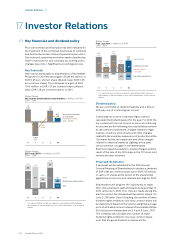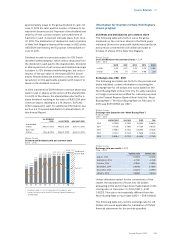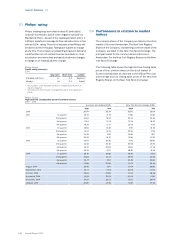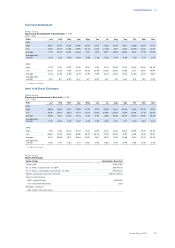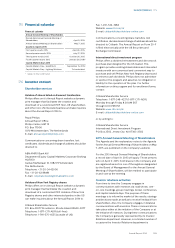Philips 2014 Annual Report Download - page 242
Download and view the complete annual report
Please find page 242 of the 2014 Philips annual report below. You can navigate through the pages in the report by either clicking on the pages listed below, or by using the keyword search tool below to find specific information within the annual report.Denitions and abbreviations 18
242 Annual Report 2014
International Standardization Organization (ISO)
The International Standardization Organization (ISO) is the world’s largest
developer and publisher of International Standards. ISO is a network of
the national standards institutes of more than 160 countries, one member
per country, with a Central Secretariat in Geneva, Switzerland, that
coordinates the system. ISO is a non-governmental organization that
forms a bridge between the public and private sectors.
Light-Emitting Diode (LED)
Light-Emitting Diode (LED), in electronics, is a semiconductor device that
emits infrared or visible light when charged with an electric current. Visible
LEDs are used in many electronic devices as indicator lamps, in
automobiles as rear-window and brake lights, and on billboards and signs
as alphanumeric displays or even full-color posters. Infrared LEDs are
employed in autofocus cameras and television remote controls and also
as light sources in ber-optic telecommunication systems.
Lives improved by Philips
To calculate how many lives we are improving, market intelligence and
statistical data on the number of people touched by the products
contributing to the social or ecological dimension over the lifetime of a
product are multiplied by the number of those products delivered in a year.
After elimination of double counts – multiple dierent product touches
per individual are only counted once – the number of lives improved by
our innovative solutions is calculated. In 2012 we established our baseline
at 1.7 billion a year.
Mature geographies
Mature geographies are the highly developed markets comprising of
Western Europe, North America, Japan, South Korea, Israel, Australia and
New Zealand.
Net debt : group equity ratio
The % distribution of net debt over group equity plus net debt.
Non-Governmental Organization (NGO)
A non-governmental organization (NGO) is any non-prot, voluntary
citizens’ group which is organized at a local, national or international level.
OEM
Original Equipment Manufacturer.
Operational carbon footprint
A carbon footprint is the total set of greenhouse gas emissions caused by
an organization, event, product or person; usually expressed in kilotonnes
CO2-equivalent. The Philips operational carbon footprint is calculated on
a half-year basis and includes industrial sites (manufacturing and
assembly sites), non-industrial sites (oces, warehouses, IT centers and
R&D facilities), business travel (lease and rental cars and airplane travel)
and logistics (air, sea and road transport).
Peruorinated compounds (PFC)
A peruorinated compound (PFC) is an organouorine compound with all
hydrogens replaced by uorine on a carbon chain—but the molecule also
contains at least one dierent atom or functional group. PFCs have unique
properties to make materials stain, oil, and water resistant, and are widely
used in diverse applications. PFCs persist in the environment as persistent
organic pollutants, but unlike PCBs, they are not known to degrade by any
natural processes due to the strength of the carbon–uorine bond.
Polyvinyl chloride (PVC)
Polyvinyl chloride, better known as PVC or vinyl, is an inexpensive plastic
so versatile it has become completely pervasive in modern society. The
list of products made from polyvinyl chloride is exhaustive, ranging from
phonograph records to drainage and potable piping, water bottles, cling
lm, credit cards and toys. More uses include window frames, rain gutters,
wall paneling, doors, wallpapers, ooring, garden furniture, binders and
even pens.
Productivity
Philips uses Productivity internally and as mentioned in this Annual Report
as a non-nancial indicator of eciency that relates the added value,
being income from operations adjusted for certain items such as
restructuring and acquisition-related charges etc. plus salaries and wages
(including pension costs and other social security and similar charges),
depreciation of property, plant and equipment, and amortization of
intangibles, to the average number of employees over the past 12 months.
Regulation on Hazardous Substances (RoHS)
The RoHS Directive prohibits all new electrical and electronic equipment
placed on the market in the European Economic Area from containing
lead, mercury, cadmium, hexavalent chromium, poly-brominated
biphenyls (PBB) or polybrominated diphenyl ethers (PBDE), except in
certain specic applications, in concentrations greater than the values
decided by the European Commission. These values have been
established as 0.01% by weight per homogeneous material for cadmium
and 0.1% for the other ve substances.
Return on equity (ROE)
This ratio measures income from continuing operations as a percentage
of average shareholders’ equity. ROE rates Philips’ overall protability by
evaluating how much prot the company generates with the money
shareholders have invested.
Return on invested capital (ROIC)
Return on Invested Capital consists of income from continuing operations
excluding results attributable to non-controlling interest holders, results
relating to investments in associates and nancial income and expenses,
divided by the average net operating capital at year end and the preceding
four quarter ends. Philips believes that ROIC information makes the
underlying performance of its businesses more transparent as it relates
returns to the operating capital in use.
SF6
SF6 (Sulfur hexauoride) is used in the electrical industry as a gaseous
dielectric medium.
Turnover rate of net operating capital
Sales divided by average net operating capital (calculated on the quarterly
balance sheet positions).
Voluntary turnover
Voluntary turnover covers all employees who resigned of their own
volition.
Waste Electrical and Electronic Equipment (WEEE)
The Waste Electrical and Electronic Equipment Directive (WEEE Directive)
is the European Community directive on waste electrical and electronic
equipment which became European Law in February 2003, setting
collection, recycling and recovery targets for all types of electrical goods.
The directive imposes the responsibility for the disposal of waste electrical
and electronic equipment on the manufacturers of such equipment.
Weighted Average Statutory Tax Rate (WASTR)
The reconciliation of the eective tax rate is based on the applicable
statutory tax rate, which is a weighted average of all applicable
jurisdictions. This weighted average statutory tax rate (WASTR) is the
aggregation of the result before tax multiplied by the applicable statutory
tax rate without adjustment for losses, divided by the group result before
tax.


